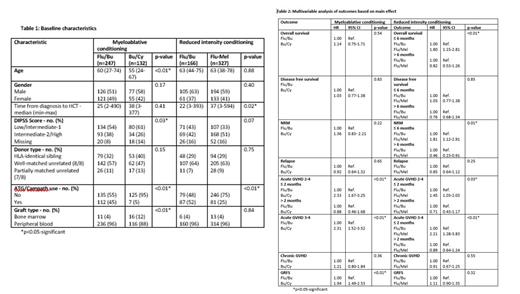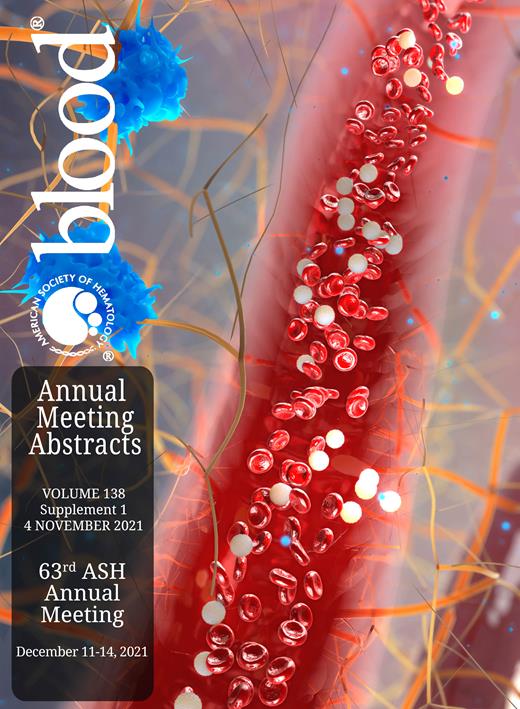Abstract
Background:
Allogeneic hematopoietic cell transplantation (allo-HCT) remains the only curative therapeutic modality for patients with myelofibrosis (MF). However, the optimal conditioning regimen for allo-HCT either in the myeloablative conditioning (MAC) or in the reduced intensity conditioning (RIC) setting is not well known.
Methods:
Using the Center for International Blood and Marrow Transplant Research (CIBMTR) database, we identified adults aged ≥18 years with MF who underwent allo-HCT between the years 2008-2018. Donor types included matched sibling donor (MSD), 8/8 matched unrelated donor (MUD), and 7/8 MUD. Outcomes were compared separately in the MAC and RIC cohorts based on the most common conditioning regimens used in each setting - MAC [(Fludarabine/Busulfan (Flu/Bu) vs. Busulfan/cyclophosphamide (Bu/Cy)] or RIC [(Flu/Bu vs. Fludarabine/melphalan (Flu/Mel)]. Overall survival (OS), disease free survival (DFS), non-relapse mortality (NRM), relapse, acute and chronic graft versus host disease (GVHD) and GVHD-free relapse-free survival (GRFS) were evaluated. Survival analysis was done using Kaplan-Meier method and significant predictors were evaluated using Cox-proportional hazard regression method. Multivariable regression model included main effect (conditioning regimen) and covariates (patient age, gender, race, CMV match, disease subtype, DIPSS at HCT, comorbidities score (HCT-CI), Karnofsky performance status, prior therapy (ruxolitinib use/splenic radiation therapy/splenectomy), interval between diagnosis and transplant, conditioning intensity, stem cell source, donor-recipient HLA-match, GVHD prophylaxis, ATG/alemtuzumab use, transplant year, and center affect). All analyses were performed at a two-sided significance level of 0.05.
Results:
Of 872 patients who met the study criteria, 379 patients underwent allo-HCT using MAC (Flu/Bu=247, Bu/Cy=132) and 493 patients using RIC (Flu/Bu=166, Flu/Mel=327). Key baseline characteristics of the patients are summarized in Table 1. In multivariable analysis, significant differences in outcomes were observed in the MAC and RIC setting based on the choice of conditioning regimen (Table 2). In the MAC setting, Bu/Cy was associated with a higher risk of acute GVHD (grade 2-4 HR 2.33, 95% CI 1.67-3.25, p<0.01; grade 3-4 HR 2.31, 95% CI 1.52-3.52, p<0.01) and inferior GRFS (HR 1.94, 95% CI 1.49-2.53, p<0.01) as compared to Flu/Bu. In the RIC setting, Flu/Mel was associated with inferior OS (HR 1.80, 95% CI 1.15-2.81, p<0.01), higher risk of NRM (HR 1.81, 95% CI 1.12-2.91, p=0.01) and acute GVHD (grade 2-4- HR 1.45, 95% CI 1.03-2.03, p=0.03; grade 3-4 HR 2.21, 95%CI 1.28-3.83, p<0.01) as compared to Flu/Bu. These higher risks associated with Flu/Mel were primarily observed early post-transplant. The results were consistent when the outcomes were evaluated based on the two common melphalan doses employed in the RIC setting (100mg/m 2 vs 140mg/m 2).
Conclusions:
Our study demonstrates that the choice of conditioning regimen significantly influences the outcomes of allo-HCT in MF. The results favor Flu/Bu based conditioning in the MAC (lesser acute GVHD and better GRFS) and RIC (better OS, lower NRM, lower acute GVHD) setting. Hence, this aspect should be explored in future studies as the modification of conditioning strategies could lead to improved outcomes.
Guru Murthy: TG therapeutics: Other: Advisory board; Cardinal Health Inc.: Honoraria; Qessential: Consultancy; Guidepoint: Consultancy; Techspert: Consultancy; Cancerexpertnow: Honoraria. Sobecks: CareDX: Membership on an entity's Board of Directors or advisory committees. Scott: Bristol Myers Squibb: Consultancy, Honoraria, Research Funding. Saber: Govt. COI: Other.


